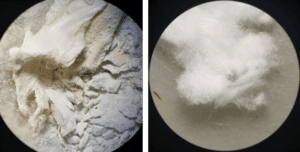One of the most frequently asked questions from our clients when receiving their asbestos identification test results is; what does the presence of “Organic Fibre” or “Synthetic Mineral Fibres” mean?
Most of the materials received in our laboratory contain some kind of fibre, and those can be reported as:
-
- Asbestos Fibres: There are 6 types of asbestos, the three most common and most used commercially are white, brown and blue asbestos. If your sample contains asbestos, the test report will state which type of asbestos is present and you will need to take action in accordance with the Health and Safety at Work Asbestos Regulations 2016. The approach to dealing with asbestos will depend on the type of material you have, friable or non-friable, regardless of the type of asbestos that is present.
-
- Organic fibres: There are several types of organic fibres, we will not specify which type it is in the report, but the most common types of organic fibre observed are cellulose, like the ones present on paper (Figure 1), natural organic fibres (e.g. coconut fibres, sisal or “horse hair”) and polymer fibres such as nylon. Most of the samples received by us that contain organic fibres are plaster, cement, paper, ropes and floor backing and they are used as a binder.
- Synthetic Mineral Fibres (SMF): There are several types of SMF, but the most common observed in building materials is fibreglass (Figure 2). Most samples received by us that contain fibreglass are insulation material and plasters.
Whilst Organic and Synthetic Mineral Fibres are not considered as harmful to your health as asbestos fibres, Synthetic Mineral Fibres are subject to Workplace Exposure Standards. This should be taken into account when working with certain SMF products.
During disposal, removal or refurbishment, the material that has been tested and identified to only contain organic and/or SMF, does not require a specialist removalist contractor. It is necessary that you or your contractor wear appropriate Personal Protection Equipment such as a respirator or face mask, disposable overalls and gloves as the removal process can release harmful dust and fibres into the air.
Figure 1 Left. Plasterboard with organic fibres and paper coating (8x magnification).
Figure 2 Right. Fibreglass used as insulation (8x magnification).
Figure 1 Left. Organic fibres observed under a Polarised Light Microscope (100x magnification).
Figure 2 Right. Fibreglass observed under a Polarised Light Microscope (100x magnification).



